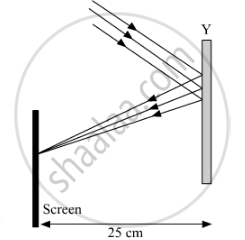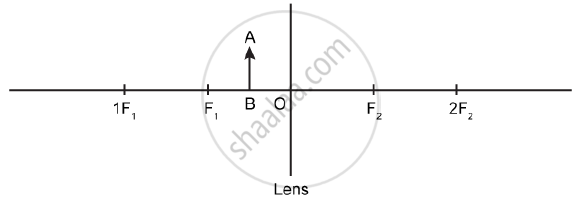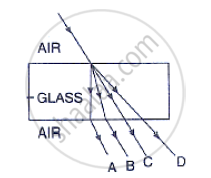Advertisements
Advertisements
प्रश्न
Observe the given figure and answer the following questions.

- Where is the above type of lens construction used?
- What type of image is formed by an objective lens?
- What happens instead of placing at Fo if the object is placed in between O and Fo?
उत्तर
- The above type of lens construction is used in a compound microscope.
- The image formed by the objective is real, inverted, and formed at a distance within the focal length of the eyepiece.
- If the object is placed in between O and Fo, a virtual image will be formed on the same side of the objective as that of the object. As a result, compound microscope will not be able to operate as expected.
APPEARS IN
संबंधित प्रश्न
Study the given ray diagrams and select the correct statement from the following:


(A) Device X is a concave mirror and device Y is a convex lens, whose focal lengths are 20 cm and 25 cm respectively.
(B) Device X is a convex lens and device Y is a concave mirror, whose focal lengths are 10 cm and 25 cm respectively.
(C) Device X is a concave lens and device Y is a convex mirror, whose focal lengths are 20 cm and 25 cm respectively.
(D) Device X is a convex lens and device Y is a concave mirror, whose focal lengths are 20 cm and 25 cm respectively.
Where should an object be placed so that a real and inverted image of the same size as the object is obtained using a convex lens?
An object AB is placed between O and F1 on the principal axis of a converging lens as shown in the diagram.

Copy the diagram and by using three standard rays starting from point A, obtain an image of the object AB.
Draw a labelled ray diagram to show how a ray of light passes through a parallel sided glass block:
if it hits the glass block at 90° (that is, perpendicular to the glass block)
Where should an object be placed in front of a convex lens so as to obtain its virtual, erect and magnified image?
A convex lens of focal length 6 cm is held 4 cm from a newspaper which has print 0.5 cm high. By calculation, determine the size and nature of the image produced.
Find the nature, position and magnification of the images formed by a convex lens of focal length 0.20 m if the object is placed at a distance of:
0.50 m
What type of images can a convex lens make?
A beam of parallel light rays is incident through the holes on one side of a box and emerges out through the holes on its opposite side as shown in the diagram below:
Which of the following could be inside the box?
(a) a rectangular glass block
(b) a concave lens
(c) a convex lens
(d) a glass prism
In figure , name the ray which represents the correct path of light while emerging out through
a glass block.

Show by a diagram the refraction of two light rays incident parallel to the principal axis on a convex lens by treating it as a combination of a glass slab and two triangular glass prisms.
A convex lens is placed in water. Its focal length will ______.
The focal length of a thin convex lens is ______ than that of a thick convex lens.
A lens forms an upright and magnified image of an object State whether the image is real or virtual
In the following cases, where must an object be placed in front of a convex lens so that the image formed is inverted and enlarged?
Analyse the following observation table showing variation of image-distance (v) with object-distance (u) in case of a convex lens and answer the questions that follow without doing any calculations:
| S. No. | Object-Distance u (cm) |
Image-Distance v (cm) |
| 1 | –60 | +12 |
| 2 | –30 | +15 |
| 3 | –20 | +20 |
| 4 | –15 | +30 |
| 5 | –12 | +60 |
| 6 | –9 | +90 |
(a) What is the focal length of the convex lens? State reason for your answer.
(b) For what object-distance (u) is the corresponding image-distance (v) not correct? How did you arrive at this conclusion?
(c) Choose an appropriate scale to draw a ray diagram for the observation at S. No. 4 and find the approximate value of magnification.
A student places a 8.0 cm tall object perpendicular to the principal axis of a convex lens of focal length 20 cm. The distance of the object from the lens is 30 cm. He obtains a sharp image of the object on a screen placed on the other side of the lens. What will be the nature (inverted, erect, magnified, diminished) of the image he obtains on a screen? Draw ray diagram to justify your answer.
Distinguish between:
Concave lens and Convex lens
The image obtained while finding the focal length of convex lens is ....................
Observe the following figure and complete the table:

| Points | Answer |
| (i) Position of the object | |
| (ii) Position of the image | |
| (iii) Size of the image | |
| (iv) Nature of the image |
Draw neat diagram to show the
Convergent action of a convex lens,
State the position of object, position of image, nature of image when: Convex lens is used as objective lens of astronomical telescope.
State the position of object, position of image, nature of image when: Convex lens is used in cine projector.
State the nature and position of the object on the principal axis to obtain a virtual and magnified image.
State the nature and position of the object on the principal axis to obtain a real image of the same size
An object is placed in front of a convex lens such that the image formed has the same size as that of the object. Draw a ray diagram to illustrate this.
_______ is a combination of two convex lenses with small focal length.
Object at 2F1 of a convex lens : Image at 2F2 : : Object at F1 : _______
Write the name.
The lens used in simple microscope.
A convex lens of focal length 20 cm can produce a magnified virtual as well as real image. Is this a correct statement? If yes, where shall the object be placed in each case for obtaining these images?
Distinguish between:
Concave lens and Convex Lens
